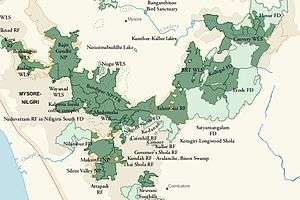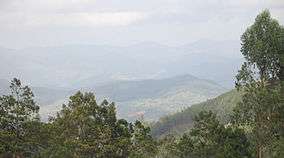Nilgiri Biosphere Reserve
| Nilgiri Biosphere Reserve | |
|---|---|
|
Nilgiri Hills from atop Doddabetta Peak | |
 Map of Nilgiri Biosphere Reserve 1/1,300,000. | |
| Location | South India |
| Coordinates | 11°33′00″N 76°37′30″E / 11.55000°N 76.62500°ECoordinates: 11°33′00″N 76°37′30″E / 11.55000°N 76.62500°E |
| Area | 5,520 km2 (2,130 sq mi) |
| Established | 1986 |
The Nilgiri Biosphere Reserve is an International Biosphere Reserve in the Western Ghats and Nilgiri Hills ranges of South India. The Western Ghats, Nilgiri Sub-Cluster (6,000+ km²), conjoining the Nilgiri Biosphere Reserve, is a World Heritage Site declared by UNESCO in 2012. It includes the Mudumalai, Mukurthi, Sathyamangalam, Nagarhole, Wayanad, and Bandipur national parks.
A fascinating ecosystem of the hill ranges of Nilgiris and its surrounding environments covering a tract of over 5000 square kilometers was constituted as Nilgiris Biosphere Reserve by UNESCO in September 1986 under Man and Biosphere Programme. Nilgiris Biosphere Reserve is India's first and foremost biosphere reserves with a heritage, rich in flora and fauna. Tribal groups like the Todas, Kotas, Irullas, Kurumbas, Paniyas, Adiyans, Edanadan Chettis, Cholanaickens, Allar,Malayan, etc., are native to the reserve.[1]
Location
The reserve encompasse 5,520 km² in the states of Tamil Nadu (2537.6 km²), Karnataka (1527.4 km²) and Kerala (1455.4 km²). It forms an almost complete ring around the Nilgiri Plateau. The biosphere lies between 10°50′N and 12°16′N latitude and 76°00′E to 77°15′E longitude.
The reserve extends from the tropical and subtropical moist broadleaf forests, tropical moist forests of the western slopes of the Ghats to the tropical and subtropical dry broadleaf forests tropical dry forests on the east slopes. Rainfall ranges from 500mm to 7000mm per year. The reserve encompasses three ecoregions, the South Western Ghats moist deciduous forests, South Western Ghats montane rain forests, and South Deccan Plateau dry deciduous forests.
Fauna
Fauna includes over 100 species of mammals, 350 species of birds, 80 species of reptiles, about 39 species of fish, 31 amphibians and 316 species of butterflies. It includes the Bengal tiger, Indian leopard (and black panther), gaur, Indian elephant, mongoose, Malabar giant squirrel, lion-tailed macaque, gray langur and nilgiri tahr.
It has largest population of two endangered species lion-tailed macaque and nilgiri tahr.[2]
Flora
The Nilgiri Biosphere Reserve is very rich in plant diversity. About 3,300 species of flowering plants can be seen here. Of the 3,300 species, 132 are endemic to the reserve. The genus Baeolepis is exclusively endemic to the Nilgiris. Some of the plants entirely restricted to the Nilgiri Biosphere Reserve include species of Adenoon, Calacanthus, Baeolepis, Frerea, Jarodina, Wagatea, Poeciloneuron, etc.
Of the 175 species of orchids found in the Nilgiri Biosphere Reserve, eight are endemic. These include endemic and endangered species of Vanda, Liparis, Bulbophyllum and Thrixspermum. The sholas of the reserve are a treasure house of rare plant species.
About 80% of flowering plants reported from Western Ghats occur in NBR.[3]
Core and buffer areas
The 1986 designation by the Government of India established core and buffer areas within the biosphere reserve.[4]
- Core area: 1240.3 km² (701.8 km² in Karnataka, 264.5 km² in Kerala, 274 km² in Tamil Nadu)
- Buffer area: 4280
Nature Film
- A Day In Nilgiri Biosphere Reserve - A Lifescape To Experience
See also
References
| Wikimedia Commons has media related to Nilgiri Biosphere Reserve. |
- ↑ About Nilgiri Biosphere Reserve (NBR) - www.nilgiribiospherereserve.com
- ↑ India:Physical Environment-P:66
- ↑ India:Physical Environment-P:66
- ↑ Ranjit Daniels, R. J. (1996). The Nilgiri Biosphere Reserve: A Review of Conservation Status with Recommendations for a Wholistic Approach to Management. Working Paper No. 16, 1996. UNESCO (South-South Cooperation Programme), Paris.
